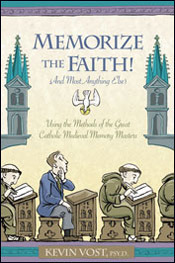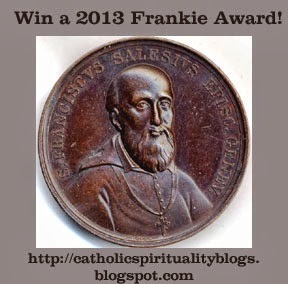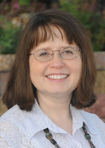Connie Rossini's Blog, page 20
November 25, 2013
Interview on Radio Maria this evening
Please join me at 7 p.m. Eastern today for a conversation about my free ebook and teaching children to pray. Frances Harry, host of Carmelite Conversations on Radio Maria, has invited me on her program. Colleen Sollinger, a longtime reader of Contemplative Homeschool, will co-host. The program is an hour long. You can listen live on the website of Contemplative Homeschool.
November 22, 2013
The suffering and death of Blessed Zelie Martin

Blessed Zelie Martin
Next week a lot of us will be making turkey soup with leftovers from Thanksgiving. We don’t throw away good food after the feast, just find another way to use it. In a similar way, I am posting today a discarded portion of my book on St. Therese. I decided to go in a different direction with my chapter on childhood tragedies. But I had already written an account of Blessed Zelie Martin’s death, and I didn’t want to waste it. So you, gentle readers, get to eat my “leftovers.” Buon Appetito, as my father-in-law likes to say.
Diagnosed with a “fibrous tumor”
In 1876, Zelie’s sister Marie-Louise, now Visitation Sister Marie-Dosithee, was dying of tuberculosis. Her imminent death shook Zelie out of the inertia caused by lack of confidence in the medical doctors available to her. For years she had resisted consulting anyone over the lingering pain in her breast. Headaches, eye-strain, and digestive problems also troubled her ). Shortly before the end of the year, she consulted Dr. Prevost. He diagnosed a “fibrous tumor”—cancer—and told Zelie an operation would be useless. At the urging of her brother and sister-in-law, she sought a second opinion from prominent surgeon Dr. Alphonse-Henri Notta in Lisieux. His conclusion was the same. It was too late to save Zelie’s life. The best doctors could do was prolong it.
Zelie wrote to Louis from Lisieux, telling him the shocking news. They tried to hide it from their children, but Pauline overheard her parents talking and insisted on knowing what was happening. Eventually, all the girls but Celine and Therese would know the truth.
Zelie strove to go on as she had before—except for the fervent prayers she and her loved ones offered for her healing. She continued working at her lace. Family duties also kept her busy, although she gave Marie the care of much of the housework.
Zelie makes a pilgrimage to Lourdes
But when her sister died on February 24, Zelie appears to have lost hope. Her health rapidly declined.
Lent came. Zelie fasted and abstained with the Church, despite her illness.
In June, Zelie, Marie, Pauline, and Leonie went on a pilgrimage to Lourdes. Before leaving, Zelie threw out the prescription Dr. Prevost had given her. She was praying for a miracle, knowing that no prescription could save her. The trip brought one trial after another. They missed a train, Leonie had swollen feet, Marie was tormented by dust in her eye, and both Pauline and Leonie had motion sickness. Marie lost her aunt’s rosary in Lourdes. Pauline lost her own, and her aunt’s medals. Zelie twisted her neck. On the way home, their bottles of Lourdes water leaked.
Never one to enjoy traveling, Zelie returned home in a worse condition than she had left. Nonetheless, she was glad she had gone. “[A]t least I have nothing to reproach myself with,” she wrote to her brother Isidore Guerin and his wife Celine. She had done all she could.
The final stages of her disease
Within days of returning home, Zelie experienced such pain at night that she could hardly sleep. Still, she rose early every morning to walk to 5:30 Mass, as she had done for years. Every few steps she had to stop and rest. The pain in her neck was excruciating.
Soon fever appeared.
Marie had been caring for Celine and Therese, the two youngest daughters. As Zelie entered the final stages of the disease, she sent them to spend their days with their cousin’s wife, Madame Leriche. Although no one had spoken to them about Zelie’s failing health, they knew she was far from well.
Zelie had no fear for the futures of her two little ones. She also knew that Pauline, the daughter most like herself, would ultimately be fine. But she had some concern over Marie, who was not drawn to either marriage or religious life at this time. And “poor Leonie,” as the final Martin sister was known, caused her much anxiety. Leonie affectionately spent every moment she could with her mother, often covering her with kisses, as though that could cure her. But it was finally clear that nothing could keep Zelie in this life long. No miracle occurred.
Anointing and death
On August 26, a priest gave Zelie the last sacraments. “I can still see the place where I stood next to Celine,” St. Therese wrote nearly twenty years later. “All five of us were in line according to age, and poor Papa was there too, sobbing.”
The Guerins were present the next day when Zelie passed away about 12:30. Before dying, Zelie looked intently at her sister-in-law Celine. Celine Guerin took this as a plea to look after the Martin children. After Zelie was laid to rest, Celine Guerin urged Louis to move his family to Lisieux to be closer to their relatives. He eagerly followed this advice.
Connie Rossini
The above information is taken from Story of a Life by Bishop Guy Gaucher (1987: Harper & Row, New York), pp. 23-25; and Contemplative Homeschool.
November 19, 2013
Memorize the Faith with your child
A few of my readers have asked me for recommendations for children’s catechesis. One of the resources we have been using for the past several months is Memorize the Faith by Contemplative Homeschool.
November 15, 2013
How to grow in holiness in 10 minutes a day

Female Saint Holding a Book by Aspertini (Wikimedia Commons).
So, you’re going to Mass and Confession regularly, and praying every day, but you want to take the next step towards God? In just ten minutes daily, you can fill your mind with thoughts of Christ that inspire and sustain you. How? By reading a good book about the spiritual life.
I do best in the practice of virtue when I am reading about Christ or the saints regularly. Why is this so?
In Conversation with Christ, An Introduction to Mental Prayer, Fr. Peter Thomas Rorhbach, OCD writes:
We live in a world devoid, in great part, of a Christian spirit, in an atmosphere and culture estranged from God… We must, if we are to remain realistically attached to Christ, combat this atmosphere and surround ourselves with a new one. Constant spiritual reading fills our minds with Christ and His doctrine—it creates this new climate for us.” (Rohrbach 1980, 142)
Every day, ideas antithetical to the Catholic faith bombard us through the television, radio, internet, and conversations in the workplace and with friends. Reading a book written by a saint is almost like conversing with him or her. It reminds us what life is really about.
Start with the Bible
The Bible should be the first book we read. We need to experience Christ in our lives. The Gospels present His character. Reading how He forgave the penitent woman gives me confidence to approach Him when I have sinned. Studying the Sermon on the Mount teaches me to do His will.
The Gospels are a wonderful source for meditation. Some writers suggest reading a short section of the Bible before bed, then meditating on it in the next morning’s prayer. We can continue to think about what we have read throughout the day, seeking to apply it in our lives. Many saints attest that as they grew closer to God, they stopped reading anything besides the Gospels.
But for those who are just beginning or somewhere in the middle, other spiritual books encourage and inspire us as well.
Other reliable books for spiritual reading
What should we read? First, we must be sure the books we choose are in line with the Catholic faith. Look for the Imprimatur and Nihil Obstat on the first few pages. They tell us that a book contains nothing that contradicts Catholic doctrine or morals. Of course, many good spiritual books of our age did not seek these designations, and some books that have them are poorly written or not centered on helping us grow closer to Christ.
Here are some solid spiritual classics:
Story of a Soul by St. Therese of Lisieux
Introduction to the Devout Life by St. Francis de Sales
The Practice of the Presence of God by Brother Lawrence
Abandonment to Divine Providence by Fr. Jean-Pierre de Caussaude
In addition, the writings of Fr. Thomas Dubay, especially Fire Within, which explains the teachings of St. Teresa of Avila and St. John of the Cross, are excellent. And Fr. Jacques Philippe has written several short books on the spiritual life that are practical and accessible for modern readers.
Don’t try to read too much at once. Ten minutes or so a day gives you plenty to think about.
St. John Bosco wrote, “Only God knows the good that can come about by reading one good Catholic book.” Delve into one today and see what good it will do you.
Connie Rossini
Share with us: What spiritual books are on your night stand right now? Do you have a favorite I didn’t mention?
Other posts you may likeContemplative Homeschool.
November 12, 2013
Do you know these Carmelite saints and blesseds?
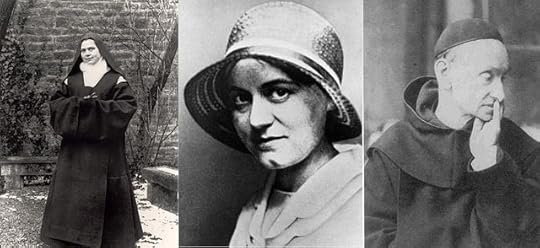
Blessed Elizabeth of the Trinity, Edith Stein circa 1920, and St. Raphael Kalinowski. (All photos from Wikipedia.)
November 13 is the first anniversary of Contemplative Homeschool. The 14th is the Feast of All Carmelite Saints. To celebrate, I’d like to introduce you to a few Carmelite saints and blesseds you may not know. In the future, I hope to delve deeper into the spiritual insights of more Carmelite saints here on my blog.
Blessed Elizabeth of the Trinity
Elizabeth Catez was born in 1880 in France. Her father was in the army. He died when Elizabeth was seven. She, her mother, and sister moved to a home in Dijon that overlooked a Carmelite monastery.
When Elizabeth made her first Communion, the mother superior told her that Elizabeth meant “House of God.” That impressed the young girl. It became the central idea of her spirituality–the realization that the Holy Trinity lived in her soul. She made a private promise of virginity at age 14 and entered Carmel at 20. She spent only five years in the cloister before her death from a prolonged illness in 1906.
During the last three months of her life, she wrote four spiritual treatises. The first was a ten-day retreat for her sister Marguerite, who was married with children. She instructed her sister on how to live a contemplative life in the world.
Following St. Therese, Elizabeth offered herself as a victim to Divine Love. She wrote, “I think that in Heaven my mission will be to draw souls into interior recollection, by helping them go out of themselves in order to cling to God by a wholly simple and loving movement, and to keep them in this great silence within which they will allow God to communicate Himself to them and to transform them into Himself.”
St. Teresa Benedicta of the Cross
Teresa Benedicta of the Cross was born Edith Stein in 1891 in Breslau, Germany. Her family was Jewish. As a teenager, she lost her faith in a personal God. However, as she studied philosophy under Edmund Husserl, she became interested in Christianity. When friend and fellow student Adolph Reinach was killed in world War I, Edith sought to comfort his widow. Instead, she was comforted by Mrs. Reinach, who had recently become a Christian. One night while staying at her home, Edith Stein picked up St. Teresa’s Life and read it straight through to the end, staying up all night. When she finished, she said, “That is the truth.” Soon afterwards she was baptized.
Edith taught high school girls and postulants at a Dominican convent. She also studied and wrote about Thomas Aquinas. Finally, she became a Carmelite nun and took the name Teresa Benedicta of the Cross. She continued her philosophical writing. She also wrote The Science of the Cross to commemorate the 400th anniversary of the birth of St. john of the Cross.
Teresa Benedicta offered herself “as a sacrifical expiation for the sake of true peace,” and for the safety and conversion of the Jewish people. In 1942, the Dutch bishops officially condemned the deportation of the Jews. The Nazis responded by arresting Catholics of Jewish descent, including Teresa and her sister Rosa, who had moved to Holland to escape danger. They spent time in two Dutch concentration camps before being transferred to Auschwitz. They were probably sent to the gas chamber upon arrival on August 9.
St. Raphael Kalinowski
Joesph Kalinowski lived a varied and at times dangerous life. He was born into a noble Polish family in 1835. He lost both his mother and step-mother at a young age. As an adult, he entered the Russian military, but was disturbed when he learned that Byzantine Rite Catholics were being forced to enter the Russian Orthodox Church. After Russia sought to suppress a Polish revolt in 1863, he asked to be discharged. He eventually joined the rebels, but was later arrested and sentenced to death. His family interceded and he was exiled to Siberia instead.
Joseph found his escape from oppression in prayer. He assisted the local priest, taught the children of other detainees, and performed acts of charity.
After his release in 1874, he became the tutor of Polish Prince Augusto Czartoyski, who was beatified in 2004. They lived in Paris. Joseph was at the time discerning entering a religious order. He settled on the Carmelites and joined them in 1877. There was only one Carmelite monastery in Poland at the time. Fr. Raphael, as he was called, wanted to revitalize the Carmelite Order in Poland. He established a monastery in Krakow.
Fr. Raphael told the friars under his care, “Our first obligation in Carmel is to have a conversation with God by our every action.” He longed for the unification of all Christians. He spread the Brown Scapular and devotion to Our Lady of Mount Carmel throughout eastern Europe.
Fr. Raphael died in Krakow in 1907.
Connie Rossini
Share with us: Who is your favorite Carmelite saint? What other Carmelite saints would you like to learn more about?
Other posts you may likeContemplative Homeschool.
November 9, 2013
Contemplative Homeschool WordPress followers, please read this!
Two weeks ago, I moved from a WordPress.com site to a self-hosted blog. I now have a professionally designed site, more options for customizing and tracking interaction with readers, and the possibility of selling my books and running others’ ads on my site. Last week I became an affiliate for Contemplative Homeschool.
November 8, 2013
Humility: the most important virtue for parents

Virgin of Humility by Fra Angelico (photo credit: Wikimedia Commons).
What’s the most important virtue you can have as a parent? A lot of things are important: patience, perseverance, consistency, understanding… But I believe the one thing that will make the most impact on your child is humility.
Admit your mistakes
Now matter how good a parent you are, you will sometimes make mistakes. You will punish the wrong child, or punish him too harshly. You will act in anger, rather than love. You will forget an important event, or forget to pick your child up from school. You will at times be selfish. You may lose or break something your child treasures.
If your focus as a parent is being patient, what happens when you fail? What happens when you are too tired to listen to your child’s concerns? What happens when it seems like you’ve messed everything up?
Do you spend the rest of the day feeling sorry for yourself, or overcome with regret?
Or do you say, “I’m sorry. I made a mistake?”
I have seen parents who did not know how to admit their errors. They never apologized to each other or to their children. They tried to teach their children to live for God, but some of the kids rebelled as they grew older. They left the Church and have stayed away for decades.
It always seemed to me that the parents’ lack of humility contributed to this. When you as a parent insist you are always right, or are offended when others point out your mistakes, it’s as though you’ve put yourself in God’s place. If your kids see you as a hypocrite, they will likely rebel against God as well.
Pride pushes kids away. Humility draws them near. If you are open with your children about your mistakes, they will return the favor and be open about theirs. They will know that you (and God) will always forgive them, because you are a sinner, and even Jesus was tempted.
Go to Confession as a family. Contemplative Homeschool.
November 5, 2013
What, you’re not a saint!?
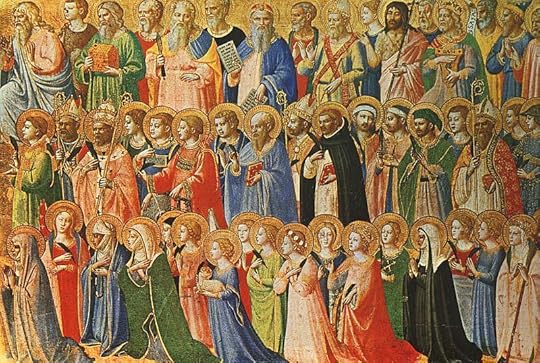
The Forerunners of Christ with Saints and Martyrs by Fra Angelico (photo credit: Wikimedia Commons).
I have a confession to make. I’m not a saint. Now, that’s no surprise to those who know me. And the better they know me, the less likely they are to think me a saint! My sins are often obvious. So, why must I “confess” I’m not a saint? Because God made me to be one. He made everyone to be a saint.
A brief history of the term “saint”
In the early years of Christianity, the word “saint” was more or less synonymous with “Christian.” After all, if God made us for holiness, and died on the Cross to give us the necessary strength, everyone who follows Jesus should reach that goal. And when professing Jesus as Lord meant possible martyrdom, people had to take their faith seriously.
Even so, not everyone did. The early Church had Her share of heretics, schismatics, and sinners. So, gradually “saint” came to mean those who were living the Christian life with abandon, then those the Church infallibly declared were in Heaven.
Throughout the Middle Ages, priests and religious were expected to be holy. God had called them in a special way. But lay people had business to care for and families to raise. They followed the teachings of the Church and tried not to commit mortal sin. But few expected much more of them than this.
The saints themselves teach us the truth about sainthood
God sent saints to re-teach us that holiness is for everyone. In the 16th century, St. John of the Cross wrote that visions and private revelations were unnecessary and dangerous for people who wanted to grow close to God. In the 17th century, St. Francis de Sales called lay people to be holy in accordance with their state in life. In the 19th century, St. Therese of Lisieux taught that holiness consisted in loving and trusting God, not necessarily in doing great deeds. And in the 20th century, St. Maximum Kolbe told his confreres, “I demand you become saints–and very great saints!”
Vatican II made the doctrine of the universal call to holiness official:
Fortified by so many and such powerful means of salvation, all the faithful, whatever their condition or state, are called by the Lord, each in his own way, to that perfect holiness whereby the Father Himself is perfect (Lumen Gentium 11).
No room for excuses
But still, we make excuses. We think others are called to the heights, not us. We excuse our sins by saying, “I’m no saint.” Read the words of St. Teresa of Avila:
O Lord! All our trouble comes to us from not having our eyes fixed upon Thee… We cry out at once: “Well, I’m no saint”; I used to say that myself.
God deliver us, sisters, from saying “We are not angels”, or “We are not saints”, whenever we commit some imperfection. We may not be; but what a good thing it is for us to reflect that we can be if we will only try and if God gives us His hand! Do not be afraid that He will fail to do His part if we do not fail to do ours (Way of Perfection Ch. 16, emphasis mine).
You see, Teresa of Avila was not always holy. She sinned, made mistakes, and sometimes forgot her purpose in life. Just like us.
The idea that saints are born holy lingers on. We think it was easy for saints to be good, because they had extraordinary graces. We gloss over their struggles, because we want to view them as different, special.
Ordinary, not extraordinary
Yes, some saints did have extraordinary graces. But that’s irrelevant. It doesn’t take extraordinary grace to be holy–only ordinary grace. The kind we receive at Baptism and through the other Sacraments. The kind that increases when we spend time in prayer, resist temptation, and make even small sacrifices out of love.
St. Paul wrote, “And I am sure that he who began a good work in you will bring it to completion at the day of Jesus Christ” (Philippians 1:6). God began the work of grace in us. He is willing and able to complete it. All He asks is our cooperation.
In cooperating with God we become saints.
So, if I ever start making excuses for my sins, please call me to task. I am not a saint–yet. But I intend to be one. And I hope you will be there ahead of me.
Connie Rossini
Share with us: How do you see yourself as different from the canonized saints? What is your favorite quote or anecdote calling ordinary people to holiness?
Other posts you may likeContemplative Homeschool.
November 1, 2013
Submit your best spirituality post for a 2013 Frankie Award!
Have you written a blog post on Catholic spirituality that your readers loved? Has another blogger’s post inspired you to grow closer to Christ? Now is the time to nominate yourself or them for a 2013 Frankie Award.
Named in honor of the great spiritual director and patron saint of journalists St. Francis de Sales, the Frankie Award recognizes the best in Catholic spiritual writing. The award winner will receive a special badge to proudly display on his or her blog, along with a $10 gift certificate to Mystic Monk Coffee. Plus, the winning post will be posted in full here at CSBN. I will promote it on social media and encourage CSBN members and our readers to do so as well.
Read the rest at my other blog Contemplative Homeschool.
October 29, 2013
Do you know these 5 facts about the Rosary?

St. Dominic Receives the Rosary from the Blessed Virgin Mary (photo credit: Wikipedia).
As this month of the Rosary comes to an end, I’d like to celebrate this wonderful prayer by sharing with you five things you may not know about its history, and how and why to pray it.
1. The Hail Mary is based on Scripture.
The first half of the Hail Mary prayer comes from two passages found in Luke’s Gospel: “Hail, full of grace, the Lord is with you” (Luke 1:28), and, “Blessed are you among women, and blessed is the fruit of your womb” (verse 42). The angel Gabriel is greeting Mary before announcing that she will be the mother of God’s Son. Next, Elizabeth is greeting and honoring Mary at the Visitation.
The second half of the Hail Mary asks her to intercede for us. Catholics believe that the saints in Heaven can pray for us, just as we can pray for each other on earth.
2. The Rosary is the lay person’s Divine Office.
You have probably heard the story about Mary revealing the Rosary to St. Dominic in the 12th century. St. Dominic did pray and teach a form of the Rosary, and may have had some kind of miraculous confirmation that the prayer was a powerful one. At the same time, historians note that the prayer developed over centuries. It originated in the Divine Office or Liturgy of the Hours.
Priests and religious pray the Divine office daily. At its core, it is a recitation of the 150 Psalms with antiphons, readings, and prayers. Lay people, who in the Middle Ages were often illiterate, wanted to join priests and religious in this prayer. Gradually, a simplified version that could be easily memorized was created. Before Pope John Paul II added the Luminous Mysteries, the full Rosary contained 150 Hail Marys. Like the Divine Office, each set of prayers ends in a Glory Be.
3. It’s intended for meditation.
For at least half my life I prayed the Rosary incorrectly! I concentrated on the words of the various prayers. Actually, we are meant to meditate upon (i.e., ponder) the mysteries assigned to each decade. The Rosary is thus a great tool to teach people Christian meditation. We picture events from the lives of Jesus and Mary and think about what they mean for us as we pray. I think this makes the Rosary an ideal vocal prayer.
4. The Church gives an indulgence to those who pray it.
If you say five decades of the Rosary in one sitting, you may receive a plenary (full)Contemplative Homeschool.

